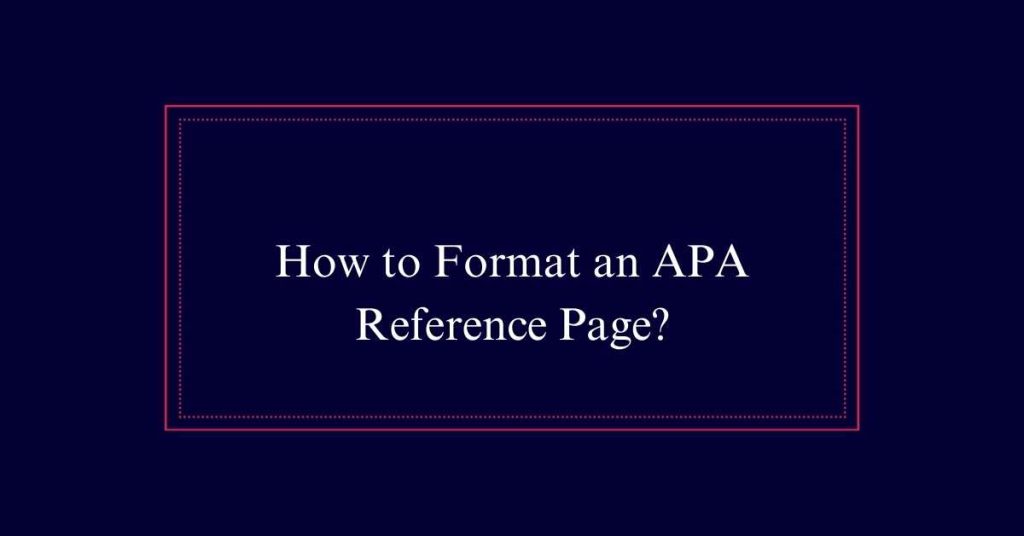How to Format an APA Reference Page?
To format an APA reference page, title the page ‘References’ in bold and center it. List entries alphabetically by authors’ last names. Use a hanging indent for each entry. Include the author’s last name, initials, publication date in parentheses, title of the work (italicized for books), and source information. Double-space the entire page for readability. Place the reference page after the main text and before any appendices.
Definition and Purpose
An APA reference page, akin to a bibliography, is an essential list of all sources used in a research paper to guarantee accuracy and prevent plagiarism. It serves as a detailed record of the research conducted, ensuring that all sources are properly credited.
Each entry provides essential information about the source, allowing readers to locate the original material if needed. This list is vital for maintaining academic integrity. The reference page is typically the last section of a document and must be formatted according to strict APA guidelines.
Properly citing sources helps to uphold the credibility of the research and acknowledges the contributions of other scholars in the field. This practice also helps to avoid accusations of plagiarism.
Essential Elements
To create an effective APA reference page, certain elements must be included for each source. These essential elements are the author’s name, publication date, title of the work, and source type.
The author’s name is listed with the last name first, followed by initials. The publication date is placed in parentheses immediately after the author’s name.
The title of the work is presented in italics if it is a book or in standard font if it is an article. The source type, such as a journal, website, or book, is detailed next.
All entries should be double-spaced with a hanging indent. Properly including these elements ensures accuracy and helps avoid plagiarism.
Alphabetical Organization
Entries on an APA reference page must be organized alphabetically by the authors’ last names. This guarantees that readers can easily locate and verify sources. When multiple works by the same author are listed, arrange them by publication year, starting with the earliest. If there is no author, use the title to determine the order. Use the following table for clarity:
| Author/Title | Publication Year | Source Type |
|---|---|---|
| Brown, A. | 2018 | Journal Article |
| Smith, J. | 2020 | Book |
| White, K. | 2017 | Conference Paper |
| ‘Zoology Studies’ | 2019 | Website |
Page Placement
After organizing your entries alphabetically, the reference page should be placed immediately after the main body of your text. This guarantees that readers can easily locate the sources you cited.
Here is a step-by-step guide to understand the correct placement:
- End of Main Text: The reference page comes right after the final paragraph of your main text.
- Before Appendices: If you have any appendices, the reference page should precede them.
- New Page: Start the reference list on a fresh page to maintain clarity and organization.
- Consistent Formatting: Make sure the reference page follows the same formatting as the rest of your document.
Formatting Guidelines
Properly formatting your reference page is essential for ensuring your work adheres to APA standards. Begin by listing your references alphabetically by the authors’ last names. Use a hanging indent for each entry, meaning the first line is flush left, and subsequent lines are indented.
Make sure the entire reference page is double-spaced. Authors’ names should be listed as initials followed by their last name. Include publication dates in parentheses immediately after the authors’ names. Titles of works should be italicized, while article titles should be in sentence case.

Make sure URLs or DOIs are presented as hyperlinks when available. Consistency and attention to detail are crucial to maintaining the integrity of your references.
Title and Spacing
When formatting your reference page, start with a bold, centered title labeled ‘References’, followed by making sure the entire page is double-spaced.
Proper spacing is essential for readability and adherence to APA guidelines.
Here are key steps:
- Title: Place the word ‘References’ in bold, centered at the top of the page.
- Spacing: Double-space all entries, including between and within references.
- Alignment: Use a hanging indent for each reference, where the first line aligns to the left margin and subsequent lines are indented.
- Consistency: Maintain uniformity in spacing and formatting throughout the page.
Author Entry Rules
To correctly format author entries on an APA reference page, follow these guidelines:
List the authors’ last names followed by their initials. For example, ‘Smith, J. A.’
If there are multiple authors, use an ampersand before the last author’s name, such as ‘Smith, J. A., & Doe, J.’
For works with up to 20 authors, list all authors. For more than 20 authors, list the first 19 followed by an ellipsis and the final author’s name.
If no author is available, start with the title.
Arrange entries alphabetically by the authors’ last names.
Use commas to separate the authors’ names and initials.
Citing Various Sources
Mastering the process of citing various sources in APA format requires understanding the specific guidelines for different types of references. Each source type has unique rules to follow.
Here are key formats:
- Books: Author(s). (Year). *Title*. Publisher.
- Journal Articles: Author(s). (Year). Title of article. *Journal Name*, Volume(Issue), pages. DOI
- Websites: Author(s). (Year, Month Date). Title of webpage. Site Name. URL
- Edited Books: Editor(s). (Ed(s).). (Year). *Title*. Publisher.
Excluded References
Maintaining certain references from the APA reference page is necessary to uphold focus on verifiable and retrievable sources.
Personal communications, such as emails and private messages, are not included because they cannot be retrieved by others. However, personal interviews are an exception and can be cited if they provide unique, valuable information.
Class notes, lecture slides, and unpublished manuscripts are also typically excluded unless they are widely accessible.
When deciding what to exclude, consider whether the source is publicly available and can be accessed by others for verification. This guarantees the reference page remains credible and useful for readers seeking to locate the original sources.
Comparison With Other Styles
Different citation styles, such as APA, MLA, and Chicago, have unique requirements for formatting reference pages. Each style serves a specific purpose and has distinct formatting rules.
Here are key differences:
- Name and Placement: APA uses a ‘References’ page, MLA uses a ‘Works Cited’ page, and Chicago often uses a ‘Bibliography’ page.
- Author Formatting: APA lists author initials, MLA uses full names, and Chicago varies but often includes full names.
- Date Placement: APA places the date after the author’s name, MLA places it at the end of the citation, and Chicago varies.
- Title Formatting: APA capitalizes only the first word and proper nouns, MLA capitalizes all major words, and Chicago varies by source type.
Frequently Asked Questions
How Do I Handle Multiple Works by the Same Author?
When handling multiple works by the same author, list the entries chronologically by year of publication, starting with the earliest. If the same year, use lowercase letters (e.g., 2020a, 2020b) to differentiate them.
What Do I Do if an Author Goes by a Pseudonym?
When an author uses a pseudonym, list the pseudonym as the author’s name. Do not include the real name. Maintain consistency by using the pseudonym in both in-text citations and the reference list.
How Should I Cite a Source With No Publication Date?
For citing a source with no publication date, use “n.d.” in place of the year. For example: Author, A. A. (n.d.). Title of work. Source. This informs readers that no date is available.
Are There Rules for Including Translated Works?
Yes, APA guidelines exist for citing translated works. Include the original author’s name, year of the translation, translated title, translator’s name, and publication details. Note the original work’s publication year in parentheses after the title.






